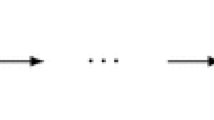Abstract
Strong consistency of infinitesimal perturbation analysis for the sojourn times in a class of tandem queueing networks is proved. Service times at the queues are correlated, and they are affine functions of the variable parameters. Differentiability of the average sojourn times is not assumed, but proved. The analysis is not based on assumptions of regenerative cycles of the networks but on stability and ergodicity of the queueing processes involved. The proof of strong consistency is based on a set of abstract conditions, described in terms of properties of the sample performance functions. These conditions are first shown to be sufficient for strong consistency, and then their validity for the networks in question is proved.
Similar content being viewed by others
References
N. Bambos and J. Walrand, “On stability and performance of parallel processing systems,”J. ACM, forthcoming.
L. Breiman,Probability, Addison-Wesley: Menlo Park, CA, 1968.
X.-R. Cao, “Realization probability in closed Jackson queueing networks and its application,”Adv. Appl. Probab., vol. 19, pp. 708–738, 1987.
X.-R. Cao and Y.C. Ho, “Sensitivity analysis and optimization of production line with blocking,”IEEE Trans. Automat. Control, vol. AC-32, pp.. 959–967, 1987.
L. Chen and R. Suri, “Convergence of infinitesimal perturbation analysis for tandem queueing systems with blocking and general service times,” manuscript, Dep. Indust. Engng., Univ. of Wisconsin-Madison, 1989.
M.C. Fu and J.Q. Hu, “Consistency of infinitesimal perturbation analysis for the GI/G/m queue,”Europ. J. Oper. Res., forthcoming (a).
M.C. Fu and J.Q. Hu, “The sample path properties of the G/D/m queue,” forthcoming (b).
P. Glasserman, “Structural conditions for perturbation analysis derivative estimates, finite time performance indices,” forthcoming.
Y.C. Ho, “Performance evaluation and perturbation analysis of discrete event dynamic systems,”IEEE Trans. Automa. Control, vol. AC-32, pp. 563–572, 1987.
Y.C. Ho, X.-R. Cao, and C.G. Cassandras, “Infinitesimal and finite perturbation analysis for queueing networks,Automatica, vol. 4, pp. 439–445, 1983.
J.Q. Hu, “Strong consistency of infinitesimal perturbation analysis for GI/G/l queues,” manuscript.
J.C. Hu, “Convexity of sample path performances and strong consistency of infinitesimal perturbation analysis estimates,”IEEE Trans. Automat. Control, forthcoming.
H. Kaspi and A. Mandelbaum, “On the ergodicity of a closed queueing network,” forthcoming.
T. Konstantopoulos and J. Walrand, “Stationarity and stability of fork-join networks,”J. Appl. Probab., vol. 26, pp. 604–614, 1989.
J.G. Shantikumar and D.D. Yao, “Second-order stochastic properties in queueing systems,”Proc. IEEE, vol 77, pp. 162–170, 1989.
K. Sigman, “Notes on the stability of closed queueing networks,”J. Appl. Probab., vol. 26, pp. 678–682, 1989.
K. Sigman, “The stability of open queueing networks,”Stochastic Process. Appl., forthcoming.
R. Suri, “Perturbation analysis: The State of the art and research issues explained via the GI/G/l queue,”Proc. IEEE, vol. 77, pp. 114–137, 1989.
R. Suri and M.A. Zazanis, “Perturbation analysis gives strongly consistent sensitivity estimates for M/G/l queues,”Management Sci., vol. 34, no. 1, 1988.
H. Thorisson, “The queue GI/G/l: Finite moments of the cycle variables and uniform rates of convergence,” Stochastic Processes and their Applications, vol. 19, pp. 85–99, 1985.
J. Walrand,An Introduction to Queueing Networks, Prentice Hall: Englewood Cliffs, NJ, 1988.
Y. Wardi, “Interchangeability of expectation and differentiation of waiting times in GI/G/l queues,” submitted.
Y. Wardi, W.-B. Gong, C.G. Cassandras, and M.H. Kallmes, “A new class of perturbation analysis algorithms for piecewise continuous sample performance functions,” submitted.
Y. Wardi and J.-Q. Hu, “Strong consistency of infinitesimal perturbation analysis for networks with correlated service times,” inProc. Amer. Control Conf., San Diego, CA, pp. 1028–1033, 1990.
Y. Wardi, M.W. McKinnon, and R. Schuckle,” On perturbation analysis of queueing networks with finitely supported service time distributions,”IEEE Trans. Automat. Control, forthcoming.
M.A. Zazanis and R. Suri, “Estimating first and second derivatives of response time for GI/G/l queues from a single sample path,” submitted.
Author information
Authors and Affiliations
Additional information
Research supported in part by the NSF under grants Nos. ECS85-15449 and CDR-8803012, under ONR contract nos. N00014-90-K-1093 and N00014-89-J-1023, and under Army contract no. DAAL-03-83-K-0171. This author is now with the Department of Manufacturing Engineering, Boston University, Boston, MA 02215.
Rights and permissions
About this article
Cite this article
Wardi, Y., Hu, J.Q. Strong consistency of infinitesimal perturbation analysis for tandem queueing networks. Discrete Event Dyn Syst 1, 37–59 (1991). https://doi.org/10.1007/BF01797142
Received:
Revised:
Issue Date:
DOI: https://doi.org/10.1007/BF01797142




